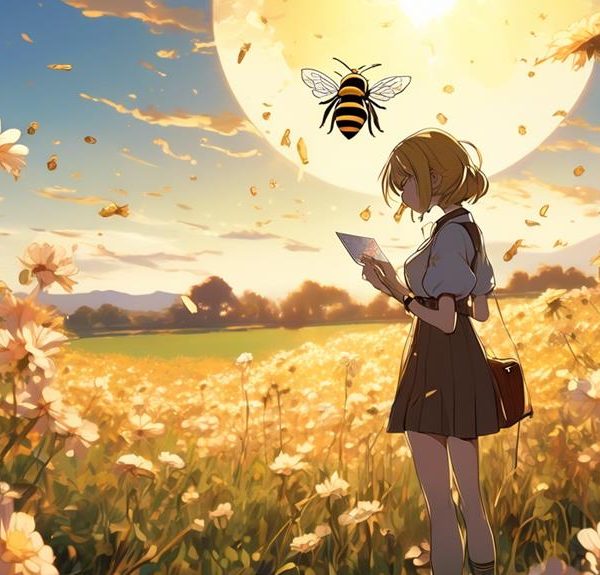Navigate the complex factors influencing your beeswax's intriguing brown hue, from the bees' diet to the cleaning process, in a revealing exploration.
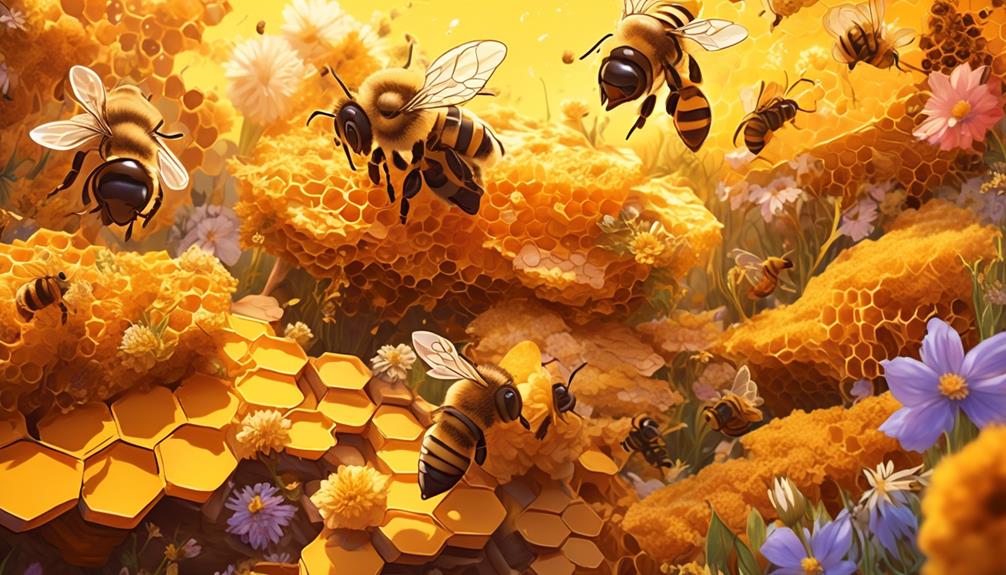
Why Is My Beeswax Brown?
Is it true that the color of your beeswax is solely determined by the type of flowers the bees visit?
It's a common belief, but the reality is more nuanced. The color of beeswax – which can range from white to dark brown – depends on a variety of factors including the bees' diet, the presence of impurities, and the process used to clean and bleach the wax.
While we're going to explore all these aspects, you'll soon discover that the story of why your beeswax is brown is far more intriguing than you might have imagined.
Key Takeaways
- Beeswax color can vary due to factors such as the age of the wax, the bees' diet, and the processing method.
- Pollen and propolis play a role in influencing the color of beeswax, with different flowers and tree sources resulting in different hues.
- Impurities and contaminants can be introduced during the production and handling of beeswax, leading to variations in color.
- Cleaning and bleaching processes can be used to remove impurities and lighten the color of beeswax, but safety precautions should be taken when handling hot wax and bleach.
Understanding Beeswax Production
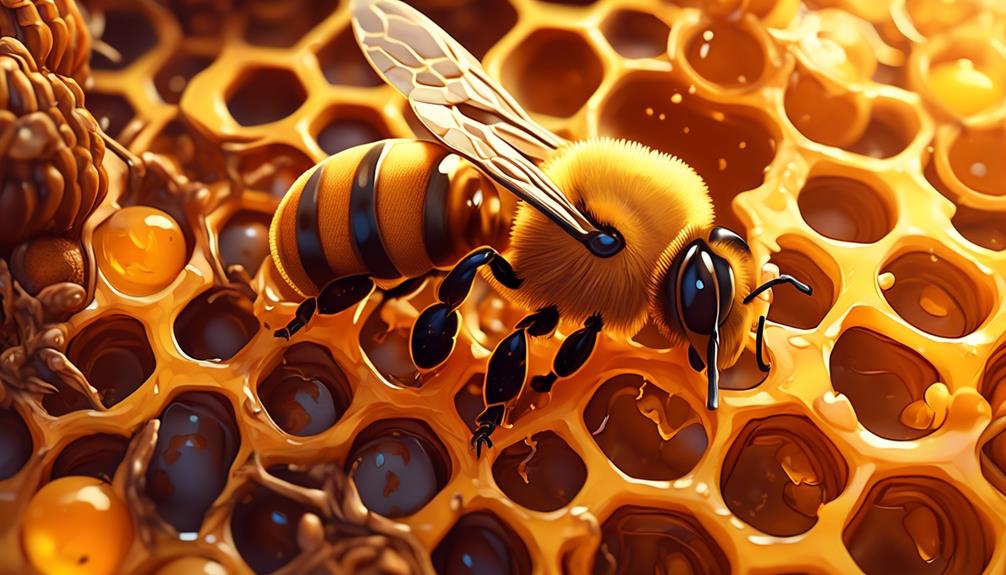
To truly appreciate brown beeswax, you need to understand its meticulous production process, beginning with the remarkable work of honeybees. The diligent bees ingest honey, and in their special glands, they convert the sugar into wax. You'd be surprised to know that it takes about eight pounds of honey to produce just one pound of beeswax.
Once the bees produce this wax, they use it to construct their intricate honeycombs, where they store honey and nurture their young. It's a fascinating process, isn't it? But that's not all. The color of the beeswax, the brown you're curious about, comes from the propolis (a sticky substance collected from tree buds) and pollen the bees incorporate into the wax.
When beekeepers harvest honey, they also collect this beeswax. They'll scrape off the caps of the honeycomb cells, a process referred to as uncapping. Then, through heating and filtering the wax, impurities are removed. The process may seem simple, but it's quite labor-intensive.
Factors Influencing Beeswax Color
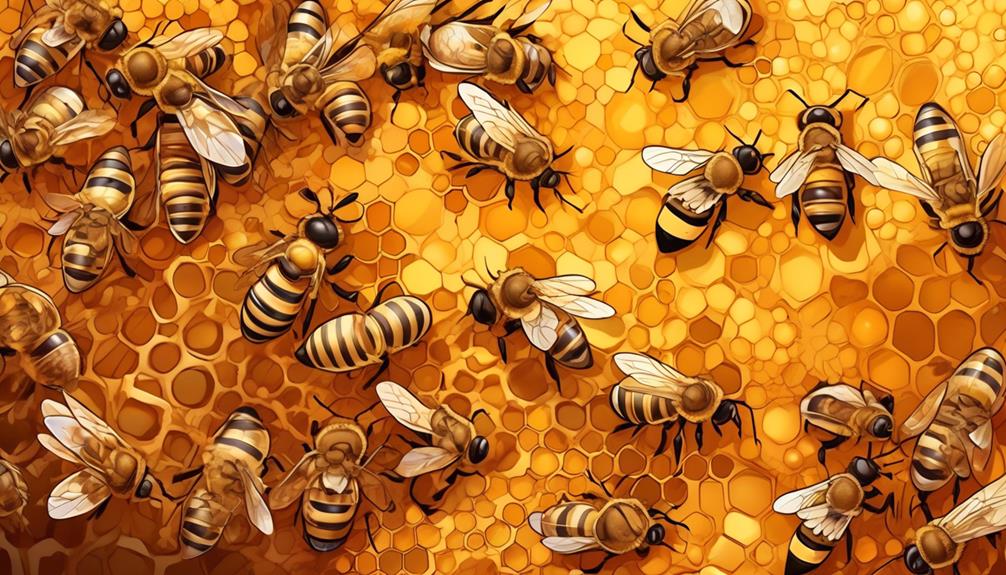
Now, while you've learned about the beeswax production process and how the brown color comes into being, let's explore how different factors can influence this color variation in beeswax. Three major factors come into play – the age of the beeswax, the diet of the bees, and the processing method.
Factor | How it Influences Beeswax Color | Emotion Evoked |
|---|---|---|
Age of Beeswax | Older wax tends to darken over time due to oxidation | Nostalgia for the passing of time |
Bees' Diet | The type of flowers the bees pollinate can affect the wax's color | Wonder at nature's variability |
Processing Method | Unfiltered beeswax retains more impurities, leading to a darker color | Respect for the craftmanship |
As beeswax ages, it undergoes oxidation which can make it appear browner. Similarly, the color of beeswax is directly related to the bees' diet. Bees that pollinate darker flowers tend to produce darker wax. Lastly, the processing method can also impact the color of your beeswax. For example, unfiltered beeswax, which retains more impurities, will be darker than filtered beeswax. So, there you have it – the mystery of brown beeswax, unraveled.
The Role of Pollen and Propolis
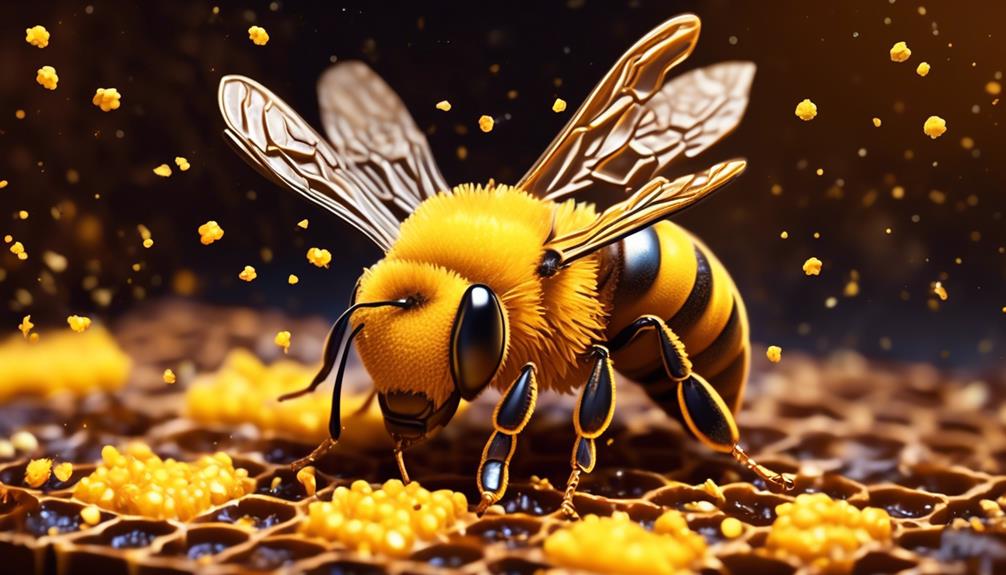
While you may already know about the impact of bees' diet and wax age on the color of beeswax, it's equally important to understand the roles of pollen and propolis in this process.
Pollen, gathered by bees from various flowers, significantly contributes to the color of the wax. Different flowers produce pollen of different colors. When bees process this pollen in the hive, it can taint the naturally clear wax with various hues. The more diverse the bees' diet, the more likely you'll see variations in wax color.
Propolis, a resinous substance bees collect from tree buds and sap flows, also influences the color of beeswax. It's often darker than wax, ranging from brown to red, and can darken the wax when mixed in. Additionally, propolis has antibacterial properties, so bees use it to sterilize their hive, further incorporating it into the wax.
You'll notice that wax from hives near diverse floral sources or trees with abundant sap flows tends to be darker. So, don't worry if your beeswax isn't perfectly golden. Instead, appreciate the natural factors that contribute to its unique hue.
Impurities and Contaminants in Beeswax

Beyond the natural factors that define its color, your beeswax's purity can also be affected by various impurities and contaminants. These can range from unwanted particles picked up during the extraction process to substances introduced during storage or handling.
It's important to note that not all impurities are harmful. Some elements, like pollen, may alter the color but are typically harmless. However, other contaminants can be more concerning. For example, pesticides used in the area where bees forage can end up in the wax. Such chemicals can't only darken your beeswax but also pose potential health risks if they're not removed.
Additionally, the process of wax purification isn't flawless. Despite thorough filtering, small particles like dust, grit, or even pieces of bee bodies can remain. These particles often settle at the bottom during the cooling process, resulting in a darker color at the base of your beeswax block.
Lastly, remember that beeswax is a natural product, and slight variations in color are normal. But, if you're worried about impurities or contaminants, consider purchasing your wax from reputable suppliers who prioritize quality and safety.
Cleaning and Bleaching Process
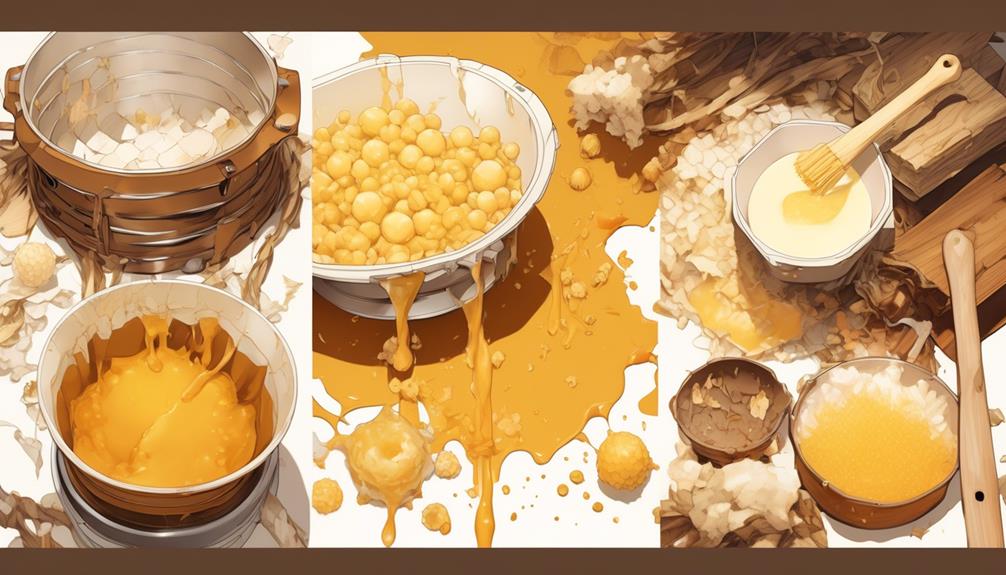
To ensure the highest quality for your projects, you'll need to understand the process of cleaning and bleaching beeswax. Beeswax naturally contains impurities such as pollen and propolis, which can affect its color and consistency. Cleaning removes these impurities, while bleaching lightens the wax's color.
Start the cleaning process by melting the beeswax in a double boiler. As the wax melts, the heavier impurities sink to the bottom. You can then strain the liquid wax through a fine-meshed cloth to remove the remaining impurities. Be sure to handle the hot wax with care to avoid burns.
Next comes the bleaching process. This can be done using sunlight, hydrogen peroxide, or other commercial bleach. Sunlight is the simplest method, but it takes longer. Simply spread the cleaned, melted wax thin on a tray and leave it in direct sunlight until it lightens. If you're using hydrogen peroxide, mix it into the melted wax and heat until the wax lightens, then cool and harden. For commercial bleach, follow the manufacturer's instructions.
Understanding these processes will help you produce cleaner, lighter beeswax for your projects. Just remember, safety is key when handling hot wax and bleach.
Frequently Asked Questions
What Are the Different Uses of Beeswax?
You can use beeswax in a variety of ways.
It's great for making candles, as it burns cleaner and longer than other types.
You'll find it in lip balms and skin care products due to its moisturizing properties.
It's also used in food wraps as a sustainable alternative to plastic.
If you're into crafting, it's handy in encaustic painting and batik dyeing.
It's even used in furniture polish to add a protective, glossy finish.
How Does the Environment Impact the Health of Bees?
The environment greatly influences bee health. If you're in an area with heavy pollution or pesticides, bees can ingest harmful substances, affecting their health and the quality of their byproducts, including beeswax.
Varied diet also impacts bee health. Limited access to diverse flora can lead to malnutrition.
Are There Any Health Benefits Associated With Consuming Beeswax?
Yes, there are health benefits to consuming beeswax.
It's rich in Vitamin A, which promotes skin health and cell reconstruction. It also has anti-inflammatory and antioxidant properties.
You'll find beeswax in many health products like lip balms and skin creams.
However, it's not typically eaten.
If you're considering ingesting beeswax, it's best to consult a healthcare professional first to ensure it's safe for you.
Can Beeswax Color Vary Based on the Type of Bee?
Yes, the color of beeswax can indeed vary based on the type of bee. It's also affected by the flowers and plants the bees have been foraging. For instance, some beeswax can be nearly white, while other varieties are a deep amber.
Don't fret over the color, it's just a sign of what your bees have been up to. It doesn't impact the quality or usability of the beeswax. It's all part of nature's wonderful diversity.
How Can I Tell if Beeswax Is Pure or Adulterated?
You can tell if your beeswax is pure or adulterated with a few simple tests.
First, smell it. Pure beeswax has a sweet, honey-like scent. If it doesn't, it's likely adulterated.
Second, touch it. It should be smooth, not sticky.
Finally, do a burn test. Pure beeswax burns with a steady, bright flame. If it's adulterated, it'll smoke or sputter.
Trust your senses and you'll know if your beeswax is pure.
Conclusion
So, your beeswax is brown due to factors like the type of flowers the bees visit, presence of pollen or propolis, impurities, and the bleaching process it undergoes. You've learned that beeswax color isn't a quality indicator.
It's all natural and a testament to the bees' hard work. Remember, whether light or dark, your beeswax is still valuable and carries the sweet essence of a bustling hive.


